In this article, you learn what is planer machine? Its diagram, types, parts of planer machine, working principle, and PDF of this article.
What is Planer Machine?
The planer machine is similar to a shaper machine. It is intended to produce plane and flat surfaces with a single-point cutting tool. A planer machine is very large and massive compared to a shaper machine. It is capable of machining heavy workpieces, which cannot fit on a shaper table.
The fundamental difference between a shaper and a planer is that
- In a planer, the work which is supported on the table reciprocates over the stationary cutting tool and the feed is provided by the lateral movement of the tool.
- In a shaper, the tool which is mounted upon the ram reciprocates. And the feed is given by the crosswise movement of the table.
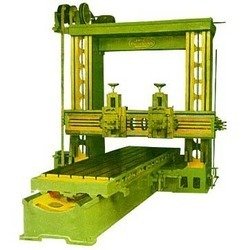
Read also: 6 Different types of Shaper Machine Operations
Parts of Planer Machine
Following are the six main parts of the planer machine:
- Bed
- Table
- Housing or Column
- Cross rail
- Tool head
- Driving and Feed Mechanism
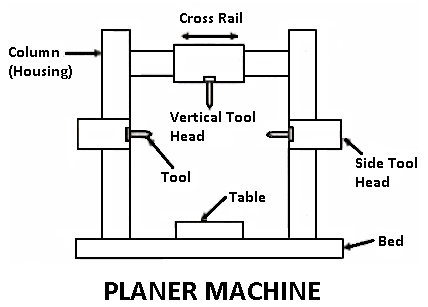
Bed
- The bed of a planer is a box-like casting having cross ribs. It is very large in size and heavy in weight and it supports the column and all other moving parts of the machine.
- The bed is made slightly longer than twice the length of the table so that the full length of the table may be moved on it.
- Three or more guideways may be provided on a very large wide machine for supporting the table.
- The guideways should be horizontal, true and parallel to each other.
- The ways are properly lubricated and in modern machines oil under pressure is pumped into the different parts of the guideways to ensure a continuous and adequate supply of lubricants.
Table
- The table supports the work and reciprocates along with the ways of the bed.
- The planer table is a heavy rectangular casting.
- T-slots are provided on the entire length of the table so that the work and work holding devices may be bolted upon it.
- At each end of the table, a hollow space is left which acts as a trough for collecting chips. Long works can also rest upon the troughs.
- In a standard planer, the table is made up of one single casting but in a divided table planer there are two separate tables mounted upon the bedways.
- Hydraulic bumpers are fitted at the end of the bed to stop the table from overrunning giving cushioning effect.
- In some machines, if the table overruns, a large cutting tool bolted to the underside of the table will take a deep cut on a replaceable block attached to the bed, absorbing the kinetic energy of the moving table.
Read also:
Housing
- The housings also called columns or uprights are rigid box-like vertical structures placed on each side of the bed and are fastened to the sides of the bed.
- They are heavily ribbed to take up severe forces due to cutting.
- The front face of each housing is accurately machined to provide precision ways on which the cross rail may be made to slide up and down for accommodating different heights of work.
- Two side-toolheads also slide upon it. The housing encloses the Crossrail elevating screw, vertical and crossfeed screws for tool heads, counterbalancing weight for the Crossrail, etc. These screws operated either by hand or power.
Cross rail
- The Crossrail is a rigid box-like casting connecting the two housings. This construction ensures the rigidity of the machine.
- The Crossrail may be raised or lowered on the face of the housing and can be clamped at any desired position by manual, hydraulic or electrical clamping devices.
- The Crossrail when clamped should remain absolutely parallel to the top surface of the table, i.e. it must be horizontal irrespective of its position.
- Usually, two toolheads, are mounted upon the Crossrail which are called railhead.
- The Crossrail has screws for vertical and crossfeed of the toolheads and a screw for elevating the rail. These screws rotated either by hand or by power.
Tool-head
The tool head of a planer is similar to that of a shaper both in construction and operation. The important parts of a tool head are:
- Saddle
- Swivel base
- Vertical Slide
- Apron
- Clapper box
- Clapper block
- Toolpost
- Down feed screw
- Apron clamping bolt,
- Apron swivelling pin
- Mechanism for cross and down-feed of the tool.
Types of Planer Machine
Following are the five types of planer machine:
- Standard or Double housing type planer machine
- open side type planer machine
- Pit planer machine
- Edge or plate-type planer
- Divided table planer
#1 Standard or Double Housing Planer Machine
The standard or double housing planer is the most widely used types of planer machine in workshops. A double housing planer has a long heavy base on which a table reciprocates on accurate guideways.
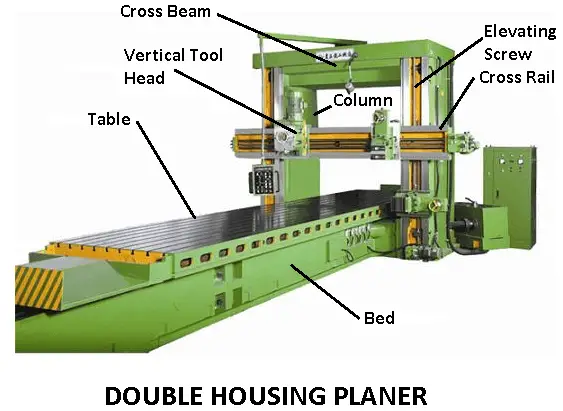
- The length of the bed is little over twice the length of the table.
- Two massive vertical housings or uprights are mounted near the middle of the base, one on each side of the bed. To ensure the rigidity of the structure, these two housings are connected at the top by a cast-iron member.
- The vertical faces of the two housing are accurately machined so that a horizontal Crossrail carrying two tool heads may slide upon it.
- The tool heads which hold the tools are mounted upon the Crossrail.
These tools may be fed either by the power in Crossrail or vertical direction. In addition to these tool heads, there are two other tool heads that are mounted upon the vertical face of the housing.
They can also be moved either in a vertical or horizontal direction to apply feed. The planer table may be driven either by mechanical or hydraulic devices.
#2 Openside Planer Machine
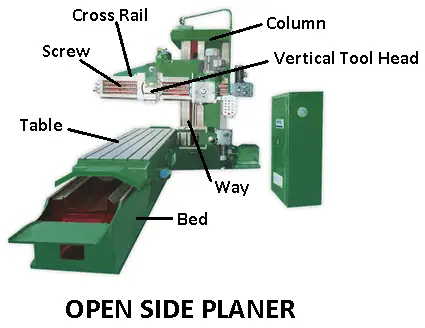
An openside planer has housing only on one side of the base. And the Crossrail is suspended from the housing as a cantilever. This feature of the machine allows the large and wide workpiece to be clamped on the table and reciprocated over the cutting tool.
On one side of the planer being opened, large and wide jobs may project out of the table and reciprocate without being interfered with by the housing.
In a double housing planer, the maximum width of the job which can be machined is limited by the distance between the two housing. As the single housing has to take up the entire load, it is made extra-massive to resist the forces.
Only three tool heads are mounted on this machine. The construction and driving features of the machine are the same as that of a double housing planer.
Read also:
- Slotter Machine: Types, Parts, Operations [Complete Guide]
- Drilling machine – Parts, It’s Types, Operations with PDF
#3 Pit Planer Machine
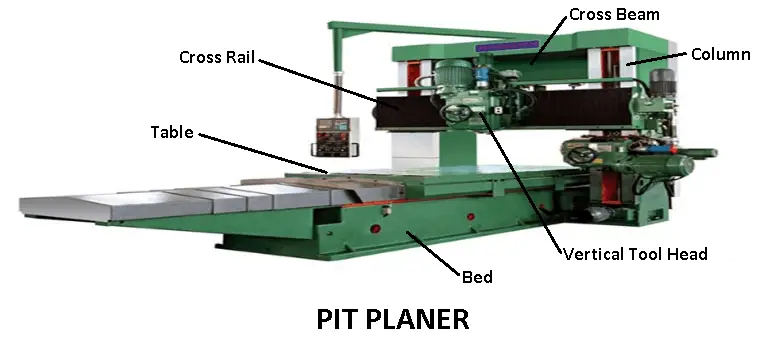
A pit-type planer is massive in construction. It differs from an ordinary planer. In this the table is stationary and the column carrying the Crossrail reciprocates on massive horizontal rails mounted on both sides of the table.
These types of planer machines are suitable for machining very large work that cannot be supported on a standard planer. This machine design saves much of floor space.
The length of the bed required in a pit-type planer is a little over the length of the table. Whereas in a standard planer, the length of the bed is near twice the length of the table. The uprights and the Crossrail are made sufficiently rigid to take up the forces while cutting.
#4 Edge or Plate Planer
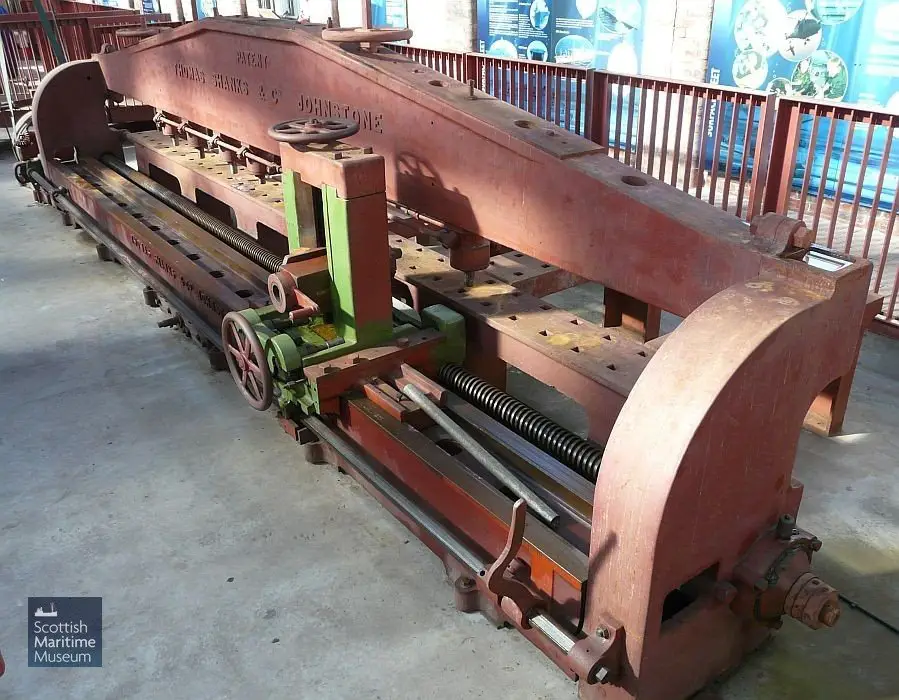
The design of a plate or edge planer is totally unlike that of an ordinary planer. It is specially intended for squaring and bevelling the edges of steel plates. Also used for different pressure vessels and shipbuilding works.
One end of a long plate which remains stationary is clamped with the machine frame by a large number so air operated clamps. The cutting tool is attached to a carriage which is supported on two horizontal ways of the planer on its front end.
The operator can stand on a platform extending from the carriage. The carriage holding the tool reciprocates over the edge of the plate. The feed and depth of cut are adjusted by the tool holder which can be operated from the platform.
#5 Divided Table Planer
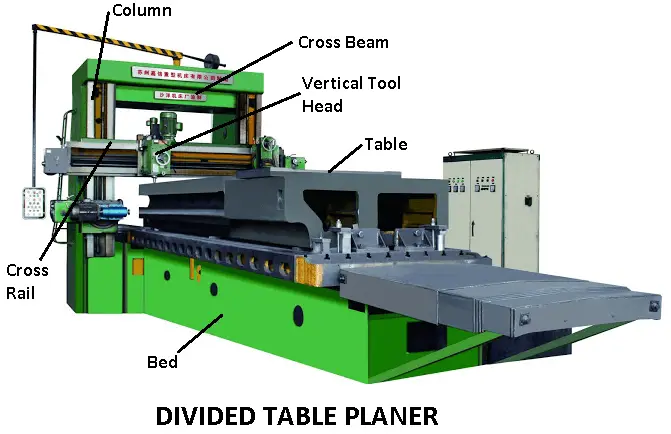
This type of planer has two tables on the bed which may be reciprocated separately or together.
This type of design saves much idle time while setting the work. The setting up of a large number of identical workpieces on the planning machine table takes quite a long time. It may require as much time for setting up as may be necessary for machining.
To have continuous production on the table is used for setting up the work. While the other reciprocates over the cutting tool finishing the work. When the work on the second table is completed, it is stopped and completed jobs are removed.
Fresh jobs are now set up on this table while the first table holding the jobs now reciprocates over the tool. When a heavy and large job has to be machined, both the table is clamped together and are given reciprocating movement under the tool.
Read Next:
Download Pdf of this article
Closing It Up
That’s it. Thanks for reading. I hope I have covered everything about the “Planer Machine” It would be helpful if you could let me know if there was anything I missed or if you have any doubts about anything I wrote.
Please share this article with your friends if you find it interesting.
Want free PDFs direct to your inbox? Then subscribe to our newsletter.
Images are from Indiamart.com
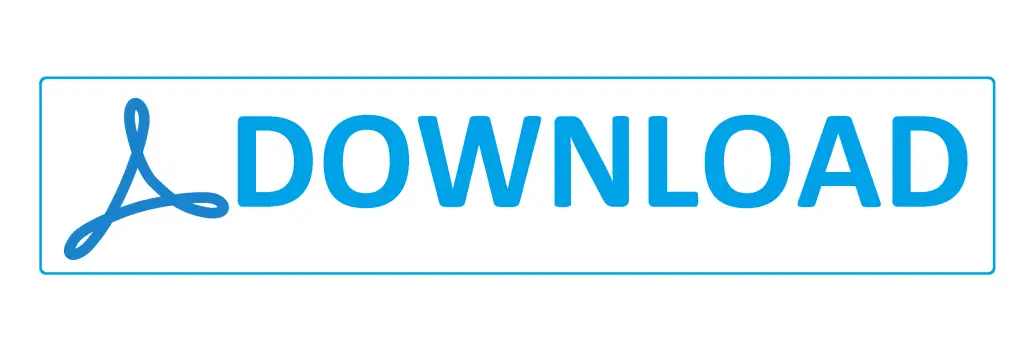
I appreciate the information provided about types of planer, but you have not provided the table drive mechanism of the divided table planer. Kindly provide the table drive mechanism of divided table planer. It will help the students who are studying in Engineering colleges, Polytechnics and specially in ITIs.
Thank you Ashok, I will update this article with more information 🙂
I got very much impressed.I never ever met anyone who knows as much about this subject as you.You are truly a knowledgeable and very intelligent person. You wrote something that very much helps people. Really, great working you are doing.
Hon sir,
Nice information.But we are unable to download or copy or to send to pendrive.
Please send the information,such that it can be uploaded.